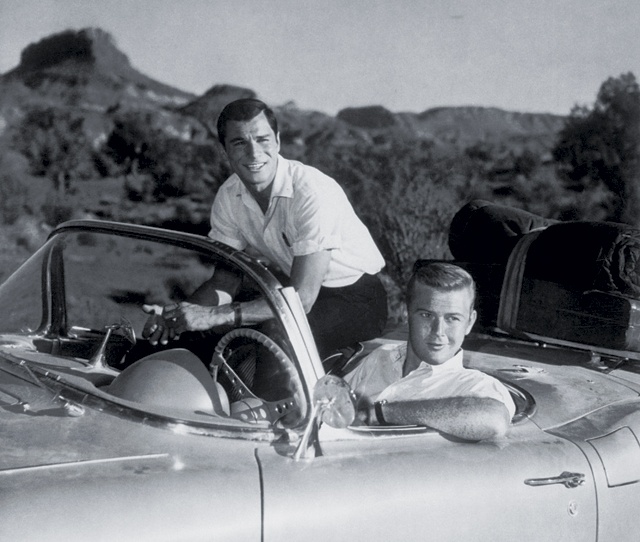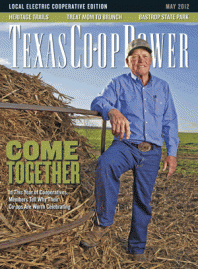I’ve been getting my kicks lately on “Route 66”—not the old song made famous by Nat King Cole, but the early 1960s television series starring a baby-faced Martin Milner as Tod Stiles and dark-haired George Maharis as Buz Murdock.
To pop-hit theme music composed by Nelson Riddle, the two young, handsome guys traveled the country in a Corvette convertible, looking for work, girls and themselves. They found all that, plus adventure. Aired weekly on CBS from 1960 through 1964, the show captured in artfully shot black-and-white footage a pre-homogenized America. From a modern perspective, the series is a time capsule of the nation’s culture and philosophy on the eve of the civil rights movement, the Vietnam War and the social upheaval of the latter half of the decade. And 12 of the shows were shot in Texas, though none were along Route 66—U.S. Highway 66, which opened in 1926, connecting Chicago to Los Angeles with hundreds of miles of road winding through eight states.
Two or three shows at a time, I’ve gone a far piece down the “Mother Road” toward my goal of seeing all 116 episodes. I have become the person I used to laugh about: a serial killer of time, someone who rents DVDs of vintage movies or TV shows and watches them over and over.
I first observed this phenomenon in my old friend Wayne, a former newspaper colleague now retired from big-time corporate public relations. He’s seen “Butch Cassidy and the Sundance Kid” 37 times.
Not only can he practically recite the 1969 film’s script word for word, Wayne’s seen the four-part “Lonesome Dove” TV miniseries seven times (run time 384 minutes), watched every episode of “The Andy Griffith Show” (249) in the order they aired, and is working on “Frasier” (264).
Asked why the needle of his figurative record player gets stuck so easily, he offers: “I’ve always believed that a show worth seeing once is worth seeing several times.”
Beyond that, Wayne continued, the human mind is capable of absorbing only so much at one time. He discovers something new every time he watches one of his favorite shows.
Even so, I used to see Wayne’s serial viewing habit as fairly eccentric, to say the least. Sure, I’m always up for seeing “Ghostbusters” one more time, but I never would have thought about watching something 37 times.
Until recently.
Visiting with a co-worker, it somehow came up that he had seen every episode of “Route 66.” I told him about Wayne, and while shaking my head over someone else having the serial-viewing bug, I did agree that I had enjoyed the show back when. In fact, I remembered when Austin—decades before the shooting of the TV show “Friday Night Lights” there would become old hat—got all atwitter when a “Route 66” episode, “Even Stones Have Eyes,” was filmed in the capital city and Kerrville in 1962.
“Well, I have the whole series on DVD if you’d like to see that episode again,” my colleague said.
I took him up on his offer. But after viewing “Even Stones Have Eyes” for the first time since the Cold War, I was hooked. (In this episode, Buz is blinded when hit by a beam during the construction of the John H. Reagan state office building and ends up at a facility for the sightless at Kerrville where he falls in love with his blind counselor. When Buz regains his sight, he and Tod soon are back on the road, but not before viewers, along with them, have learned a fundamental truth or two about life.)
The first episode of the show filmed in Texas was “Sheba,” in El Paso. It aired on January 6, 1961. Tod and Buz didn’t get back to the Lone Star State until early 1962, when they spent several weeks here.
That year’s visit resulted in: “A Long Piece of Mischief,” Mesquite, January 19; “1800 Days to Justice,” Crandall, January 26; “Aren’t You Surprised to See Me?,” Dallas, February 16; “Even Stones Have Eyes,” Austin-Kerrville, March 30; “Love is a Skinny Kid,” Lewisville, April 6; and “Kiss the Maiden All Forlorn,” Dallas, April 13.
A couple of the Dallas-area installments are prime examples of what made the show good—interesting characters and storylines coupled with 100 percent on-location footage. “Love is a Skinny Kid” captures Lewisville when it was still a small country town. “Kiss the Maiden All Forlorn,” a tale loosely based on the story of convicted embezzler and expatriate Ben Jack Cage, shows Dallas as it appeared only 19 months before the assassination of President John F. Kennedy. There are skyline views and exterior and interior shots at the Dallas police department as well as footage of the old Dallas Times-Herald building, including views of the newsroom and wire service teletype machines that would go berserk on November 22, 1963, the day Kennedy was slain.
Having hit North and Central Texas, the cast and crew returned in early 1963 for five more Texas episodes: “Somehow It Gets to Be Tomorrow,” Corpus Christi, February 15; “In the Closing of a Trunk,” Corpus Christi, March 8; “The Cage Around Maria,” Houston, March 15; “Fifty Miles from Home,” Houston, March 22; and “Narcissus on an Old Red Fire Engine,” Galveston, March 29.
The show’s producers never filmed in the Piney Woods of East Texas, along the River Walk in pre-HemisFair San Antonio, the citrus groves of the Rio Grande Valley, the vastness of far West Texas (except El Paso) or the Panhandle. But thanks to digital technology, with “Route 66” or any other favorite show, the road goes on forever for those willing to spend the time to take it.
——————–
Mike Cox, frequent contributor


